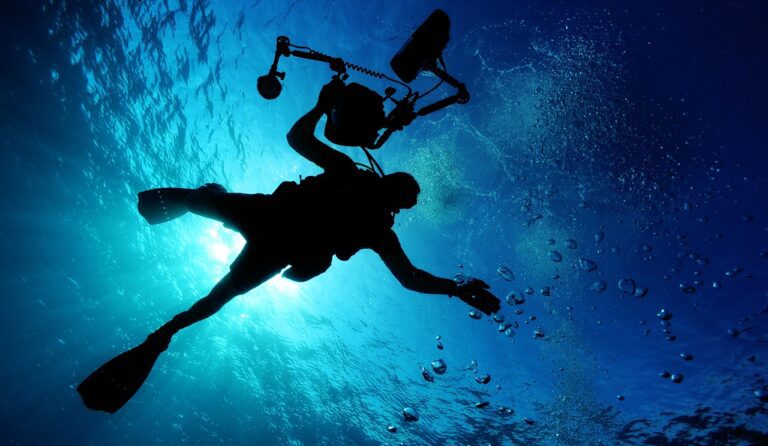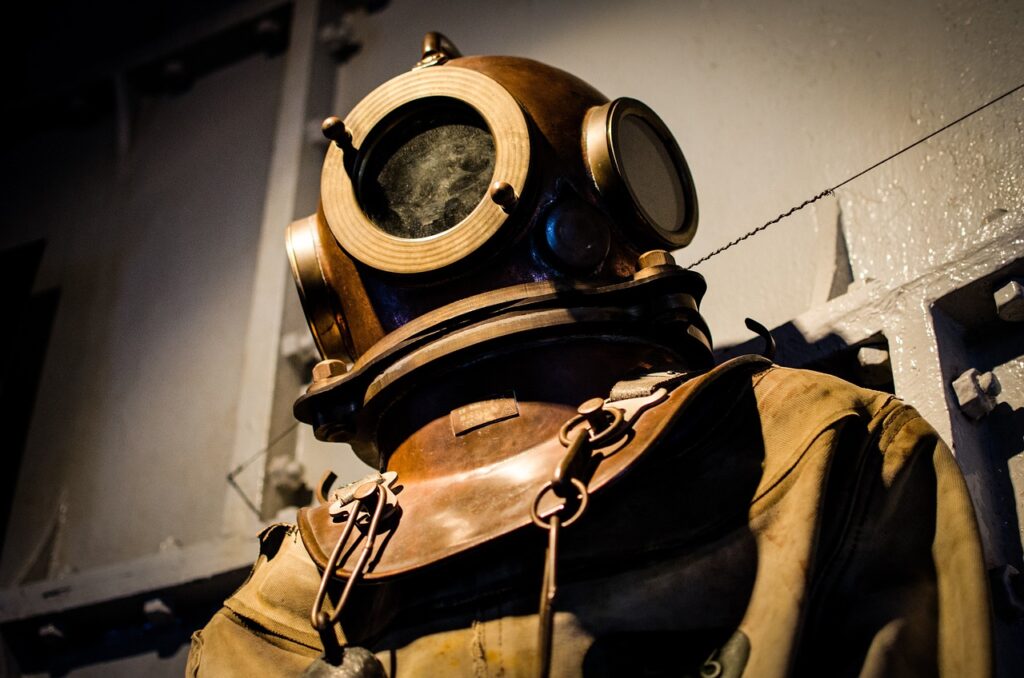Scuba diving has come a long way since its beginning, evolving from a dangerous and experimental activity to a popular and relatively safe recreational pursuit. The advancements in scuba diving gear and technology over the years have played a crucial role in making the sport more accessible, enjoyable, and safe for divers of all levels.
For dive enthusiasts, learning about this technology helps them appreciate the sport more and understand the innovations that shaped modern scuba diving.

Scuba diving has come a long way since its beginning, evolving from a dangerous and experimental activity to a popular and relatively safe recreational pursuit. The advancements in scuba diving gear and technology over the years have played a crucial role in making the sport more accessible, enjoyable, and safe for divers of all levels.
For dive enthusiasts, learning about this technology helps them appreciate the sport more and understand the innovations that shaped modern scuba diving.
1. The Early Days of Scuba Diving: A Glimpse into the Past
The origins of scuba diving can be traced back to the early 20th century, with pioneering figures like Jacques-Yves Cousteau and Emile Gagnan, who co-invented the Aqua-Lung in 1943. The Aqua-Lung was the first commercially successful open-circuit, self-contained underwater breathing apparatus (SCUBA), and it revolutionized underwater exploration. Before this invention, divers were largely dependent on surface-supplied air through cumbersome helmets and hoses, which severely limited their mobility and depth.
The Aqua-Lung allowed divers to carry their own air supply, giving them unprecedented freedom to explore the underwater world. However, early scuba gear was far from perfect. The regulators were often bulky and difficult to control, and the technology lacked the sophisticated safety features we see today. Despite these limitations, the Aqua-Lung marked a significant leap forward in the evolution of scuba diving technology.
2. Advancements in Scuba Diving Gear: From Basic to High-Tech
As scuba diving grew in popularity, so did the demand for more advanced and reliable gear. Over the decades, several key developments have transformed the equipment used by divers:
- Regulators: Early regulators, like the original Aqua-Lung, were single-stage designs that delivered air at a constant pressure, regardless of the diver’s depth. This could make breathing difficult and uncomfortable at greater depths. The introduction of two-stage regulators in the 1950s was a major improvement, allowing for more precise control of air delivery and making breathing easier and more natural underwater. Modern regulators are even more advanced, featuring balanced systems that maintain consistent airflow regardless of depth or tank pressure, as well as environmental sealing to prevent freezing in cold water.
- Buoyancy Control Devices (BCDs): The development of the BCD in the 1970s was another game-changer for divers. Early divers had limited options for controlling their buoyancy, often relying on cumbersome weight belts or even using their lungs to control ascent and descent. The BCD, a jacket-like device that can be inflated or deflated to control buoyancy, gave divers precise control over their position in the water. Today’s BCDs come with integrated weight systems, multiple air pockets for better stability, and even automated buoyancy systems that adjust according to depth.
- Dive Computers: In the early days, divers had to rely on depth gauges and dive tables to calculate their dive profiles and avoid decompression sickness. This process took time and could easily lead to mistakes. The advent of dive computers in the 1980s revolutionized this aspect of scuba diving. These devices continuously monitor depth, time, and decompression limits, providing real-time data to the diver and significantly reducing the risk of decompression sickness. Modern dive computers are even more advanced, featuring integrated air management, GPS, and wireless connectivity for dive logging and analysis.
- Wetsuits and Drysuits: The development of wetsuits and drysuits has greatly expanded the range of conditions in which divers can safely operate. Early divers had little protection from the cold, limiting their dives to warmer waters. The introduction of neoprene wetsuits in the 1950s provided insulation by trapping a thin layer of water between the suit and the skin, which is then warmed by body heat. For colder environments, drysuits were developed, which keep the diver completely dry by sealing out water and allowing for the addition of insulating layers underneath. Modern wetsuits and drysuits are more flexible, durable, and thermally efficient than ever before, allowing divers to explore a wider range of environments.
- Underwater Communication Systems: Communication between divers and with the surface has always been a challenge. Early systems relied on hand signals and slates, which could be limiting in emergency situations. The introduction of underwater communication systems, including full-face masks with built-in microphones and receivers, has greatly improved diver safety and coordination. These systems allow for clear, real-time communication, which is especially valuable during technical or deep dives where precise coordination is critical.
Rebreathers: Traditional open-circuit scuba systems release exhaled gas into the water, which limits the duration of a dive and produces bubbles that can disturb marine life. Rebreathers, which recycle the diver’s exhaled breath by scrubbing out carbon dioxide and adding fresh oxygen, offer a significant advancement. These systems allow for longer dives, reduced gas consumption, and a bubble-free experience, making them ideal for deep or extended-range diving. Modern rebreathers are more compact, reliable, and easier to use than earlier models, opening up new possibilities for exploration.

3. Improving Safety Through Technology
Safety has always been a primary concern in scuba diving, and technological advancements have played a critical role in reducing the risks associated with the sport.
- Redundant Systems: Modern scuba diving gear often includes redundant systems, such as alternate air sources (octopus regulators) and dual tank setups. These provide backup options in case of equipment failure, significantly enhancing diver safety.
- Surface Marker Buoys (SMBs) and Dive Flags: The introduction of SMBs and dive flags has improved diver visibility at the surface, reducing the risk of boat accidents. These devices are now considered essential safety gear for open-water diving.
- Advanced Decompression Algorithms: Dive computers now use advanced decompression algorithms that take into account various factors such as age, fitness level, and dive history to provide personalized safety recommendations. This has made it easier for divers to plan and execute complex dives with reduced risk.
- Rescue and Emergency Equipment: The availability of portable oxygen kits, automated external defibrillators (AEDs), and other emergency equipment at dive sites has improved the chances of survival in the event of an accident. Dive guides and instructors are also better trained in emergency response and first aid, further enhancing safety.
4. The Impact of Technology on the Diving Experience
The evolution of scuba diving technology has not only improved safety but also enhanced the overall diving experience.
- Accessibility: The advancements in scuba gear have made diving more accessible to people of all ages and skill levels. Lightweight, user-friendly equipment, combined with improved training programs, has opened up the underwater world to a broader audience.
- Exploration and Research: Technological innovations such as underwater drones, submersibles, and advanced imaging systems have expanded the possibilities for exploration and research. Divers can now reach greater depths, capture high-resolution images, and explore previously inaccessible areas, contributing to our understanding of the marine environment.
- Environmental Awareness: Modern technology has also fostered greater environmental awareness among divers. For example, eco-friendly dive gear made from sustainable materials and advanced dive computers that track and minimize environmental impact are helping to preserve the marine ecosystems that divers cherish
5. Looking to the Future: What’s Next in Scuba Diving Technology?
As technology continues to evolve, the future of scuba diving looks promising.
- Smart Diving Gear: The integration of artificial intelligence (AI) and smart technology into scuba gear is on the horizon. Imagine dive computers that can learn your diving patterns and provide personalized recommendations, or masks with augmented reality displays that overlay dive site maps and marine life identification information.
- Improved Rebreathers: Continued advancements in rebreather technology are expected to make these systems even more accessible, reliable, and affordable. This could lead to a shift away from traditional open-circuit systems for many types of diving.
- Environmental Monitoring: Future dive gear may include built-in sensors that monitor water quality, temperature, and other environmental factors, providing valuable data for marine conservation efforts.
- Sustainable Innovations: As the diving community becomes more environmentally conscious, we can expect to see more innovations focused on sustainability, such as biodegradable wetsuits, solar-powered dive computers, and eco-friendly dive operations.
The evolution of scuba diving technology has dramatically transformed the sport, making it safer, more accessible, and more enjoyable for divers around the world. From the early days of the Aqua-Lung to the advanced dive computers and rebreathers of today, each innovation has brought us closer to the underwater world we love to explore.
For dive enthusiasts, understanding the history and future of scuba diving technology not only deepens their appreciation of the sport but also highlights the incredible advancements that continue to shape the way we dive. As technology progresses, the future of scuba diving promises even greater adventures and discoveries beneath the waves.
Author: Zach Yanuario


